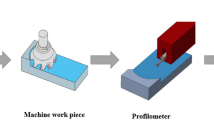Abstract
This paper presents an experimental study to optimize the surface quality of an end-milled surface on a Vertical Machining Centre using Taguchi’s nested experimental design. The effect of various machining parameters on surface roughness was investigated on two different work piece materials, Aluminium alloy and Plain Carbon Steel. Other control factors, namely, feed rate and spindle speed, depth of cut and radial engagement of tool were varied in the experiment to measure surface roughness at four different positions on the work piece. Position was taken as an uncontrollable noise factor. Depth of cut was observed to be the most significant factor that affecting the surface roughness. Also, better surface finish was obtained while machining aluminum alloy as compared to plain carbon steel. Spindle speed and feed rate were the other two significant factors while machining aluminum alloy parts, although these factors did not significantly affect the finish for steel. Radial engagement of tool had no impact on the surface finish for aluminium alloy, while it had a significant impact for plain carbon steel. Further, the analysis of results shows that position P2 (middle of the milled surface) had the best surface finish while position P1 (at beginning of the cut) had relatively poorer finish.












Similar content being viewed by others
References
Yalçın B, Özgür AE, Koru M (2009) The effects of various cooling strategies on surface roughness and tool wear during soft materials milling. J Mater Des 30(3):896–899. doi:10.1016/j.matdes.2008.05.037
Prakasvudhisarn C, Kunnapapdeelert S, Yenradee P (2009) Optimal cutting condition determination for desired surface roughness in end milling. Int J Adv Manuf Technol 41(5–6):440–451. doi:10.1007/s00170-008-1491-8
Routara BC,. Bandyopadhyay A, Sahoo P (2009) Roughness modeling and optimization in CNC end milling using response surface method: effect of workpiece material variation. Int J Adv Manuf Technol 40(11–12): 1166–1180, doi: 10.1007/s00170-008-1440-6
Ryu SH, Choi DK, Chu CN (2006) Roughness and texture generation on end milled surfaces. Int J Mach Tools Manuf 46:404–412
Lou SJ, Chen JC (1997) In-process surface recognition of a CNC milling machine using the fuzzy nets method. Comp and Indl Engg 33(1–2):401–404
Zhang JZ, Chenb JC, Kirby ED (2007) Surface roughness optimization in an end-milling operation using the Taguchi design method. J Mater Process Technol 184:233–239
Chevrier P, Tidu A, Bolle B, Cezard P, Tinnes JP (2003) Investigation of surface integrity in high speed end milling of a low alloyed steel. Int J Mach Tools Manuf 43:1135–1142
Ho Wen-Hsien, Tsai Jinn-Tsong, Lin Bor-Tsuen, Chou Jyh-Horng (2008) Adaptive network-based fuzzy inference system for prediction of surface roughness in end milling process using hybrid Taguchi-genetic learning algorithm. J Expert Sys with Appln. doi:10.1016/j.eswa.2008.01.051
Gologlu C, Sakarya N (2008) The effects of cutter path strategies on surface roughness of pocket milling of 1.2738 steel based on Taguchi method. J Mater Process Technol 206:7–15
Amina Nurul AKM, Dolaha SB, Mahmuda MB, Lajis MA (2008) Effects of workpiece preheating on surface roughness, chatter and tool performance during end milling of hardened steel D2. J Mater Process Technol 201:466–470
Rahman M, Senthil Kumar A, Manzoor-Ul-Salam LingMS (2003) Effect of chilled air on machining performance in end milling. Int J Adv Manuf Technol 21:787–795
Ryu SH, Choi DK, Chu CN (2006) Roughness and texture generation on end milled surfaces. Int J Mach Tools Manuf 46:404–412
Bagci E, Aykut S (2006) A study of Taguchi optimization method for identifying optimum surface roughness in CNC face milling of cobalt based alloy. Int J Adv Manuf Technol 29:940–947
Chang CK, Lu HS (2007) Design optimization of cutting parameters for side milling operations with multiple performance characteristics. Int J Adv Manuf Technol 32:18–26
Smith GT (2002) Industrial metrology––surfaces and roundness. Springer, London
Ross PJ (1995) Taguchi techniques for quality engineering, 2nd edn. McGraw-Hill, New York
Author information
Authors and Affiliations
Corresponding author
Rights and permissions
About this article
Cite this article
Patel, K., Batish, A. & Bhattacharya, A. Optimization of surface roughness in an end-milling operation using nested experimental design. Prod. Eng. Res. Devel. 3, 361 (2009). https://doi.org/10.1007/s11740-009-0177-x
Received:
Accepted:
Published:
DOI: https://doi.org/10.1007/s11740-009-0177-x




